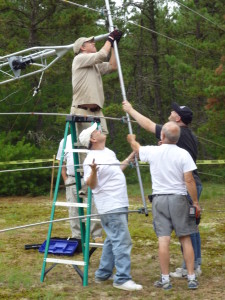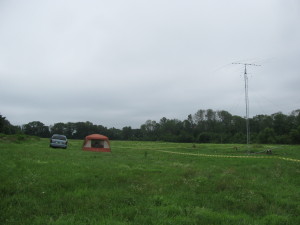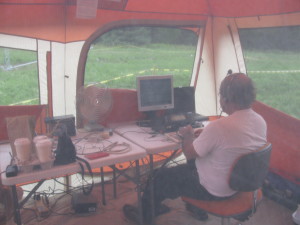We recently received some nice follow up pictures and articles about the 2013 station test that we wanted to share. Look for another article to appear in an upcoming issue of the NCJ.
Rick Booth, KM1G, wrote a nice article about the 2013 station test for the 3864 net’s “Irregular Newsletter.” 3864_news_wrtc_km1g
Joe Harris, N1QD, wrote up his experience for August 2013 edition of The SPARC newsletter of the Boston Amateur Radio Club. See page 3.
 K3ZJ provided some excellent photos and captions of his WRTC station test experience in Myles Standish park. Watch the slide show.
K3ZJ provided some excellent photos and captions of his WRTC station test experience in Myles Standish park. Watch the slide show.
Mitch, W1SJ, contributed this article he wrote for the August newsletter of the Radio Amateurs of Northern Vermont:
WRTC TEST PART II
Mitch W1SJ
The World Radio Team Championship is the Olympics of Amateur Radio. The best operators (59 two-person teams) from all over the world will be selected based on their performance in contests over the last 3 years. In July, 2014, the best of the best will be invited to New England to compete head to head in the IARU Contest. They will operate from “Field Day” type stations, using identical antennas, generators and tents. The competitors will bring their own radios, computers and skills to the competition.
Recently we just completed the 2013 WRTC dry run. We erected 25 stations and antennas all located along the I-495 corridor around Boston. And then we operated those stations in the 24-hour contest to make sure they were, indeed, identical, and that we uncovered any problems or issues.
Brian K1LI and I participated in this event. We had two jobs – the beam team (antenna and tower erectors) and the operating team. To say that we were tired after a weekend of setting up, operating 24 hours and then taking down is an understatement.
The WRTC is unique in that it is a contest within a contest. We operate in a 2-transmitter, 2-operator format. That is, we have two radios connected to a triplexer allowing both radios use of the same triband antenna at the same time, on different bands. And unlike the IARU contest, we look for DXCC countries and HQ stations while IARU competitors look for ITU zones and HQ stations. Confused yet? Many of us were last year!
Brian was able to secure the loan of an Elecraft K3 from Al KE1FO. We set up the station using two K3’s, running off of N1MM Logger on networked computers. Compared to some of the other stations, we had a relatively simple but very effective setup. It was a bit scary for me as I’ve logged over a ¼ million contacts in the last 25 years on an ancient version of NA, using an even more ancient TS830s transceiver (it has tubes in it!). The week before, we got together to set up the computers so that they communicated with the radios, they could key CW and that they were networked together. We ended up with a plethora of Ethernet, USB and serial cables and even a router! It all worked on my kitchen table, so we felt confident we could pull this off!
Friday morning, we all convened at the Medfield State Hospital, our assigned location. Formerly known as the Medfield Insane Asylum, it seemed the perfect place for a ham operation. The hospital was closed in 2003 and it consists of 50+ shuttered brick buildings. It was used as a location for the movies, “Shutter Island” and “The Box”. As nightfall descended, you could not have found a more spookier place. Maybe we should come back on Halloween.
We were to set up two stations, in fields on the East and West ends of the property. Our group consisted of 8-10 people who were on the beam and site teams and we all worked together. I paired with someone to build the 8 element Cycle 24 TX38 yagi, while others worked on the tower and tent. About mid-way through the day, some of the team started at the other site. By 5PM we had both sites put together and tested. Brian and I thought about setting up the station, but instead we opted to join the group for dinner and the telling of tall contest tales. We also know that next year, we will all have to build FOUR of these stations!
Saturday morning, I headed over to the site at O’dark thirty. Why so early? This contest starts at 8AM! We got the station set up quickly, but the network would not work. I hate this type of thing. We finally changed the workgroup name on one the computers, jumbled around some IP addresses and then reboot everything and we were on the air. We only lost 10 minutes at the beginning.
The 10 minutes we lost didn’t amount to anything since we couldn’t work anyone. The Europeans were all happily working each other and did not hear many U.S. stations. Although our beam had 8 elements, only 2 each are used on 20 and 15 meters. That and 100 watts did not set any radios on fire in Europe. After some real slow hours, we gave up and turned the beam west and ran stateside on CW. We did real well at this – both stations blazing away on CW. Then we got our only good run of the day on phone and ran up some terrific rates. But I knew we were bottom-feeding – I term I coined describing running stateside. A big part of this contest is working multipliers and we were not doing that. Finally, conditions improved to Europe and we were able to fill in all the missing multipliers.
How did the radios work while using the same antenna? Very well! The triplexer and filters worked very well – we weren’t aware of each other, nor the other station at Medfield, which was only 1500 feet away. However, when we moved to 40 and 80 meters, the K3’s complained about Hi RFI. Apparently RF was flowing down the shield of the coax to the radios – a common problem when using dipoles without baluns. Brian just happened to have a pair of common mode filters which solved the problem. Talk about packing the right tools for the job!
We both operated continuously for the 24 hour period save for a brief 45 minute nap we took at different times during the graveyard shift. And then at 8AM, it was all over, and we took down antennas, packed up and said our goodbyes until next year. I picked up Debbie from where she was staying nearby and she drove back. I passed out some two exits down I-495 and didn’t come to until we were well into Vermont!
We submitted our log on a memory stick and a few days later the results came back: 4th place out of a field of 25 stations with some of the best contesters in New England. We did very well in QSO’s while doing rather poorly with multipliers. Still, I was impressed as we did most of our operating on CW, which is not my strongest mode.
Next year will be the big bash. Competitors will arrive Wednesday, we’ll have opening ceremonies Thursday and then we put up antennas. The beam team will get a much needed rest during the competition only to reconvene on Sunday for take down.
If you can swing the time off and a place to stay, this is an opportunity you won’t want to miss. We will get to rub shoulders with the best ops in the world while showing off our hospitality. All sorts of volunteers are still needed – not only for the beam and setup teams, but also for the hospitality team – the folks who tend to the competitors and make sure they get to the event on time! Go to www.WRTC2014.org for details on volunteering. Hope you can join in on the fun!


